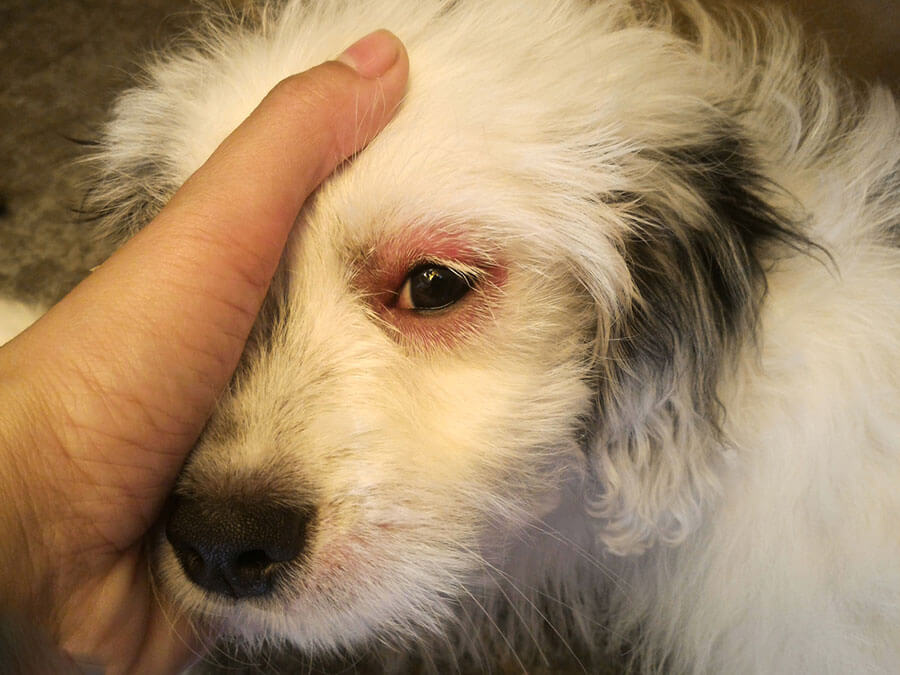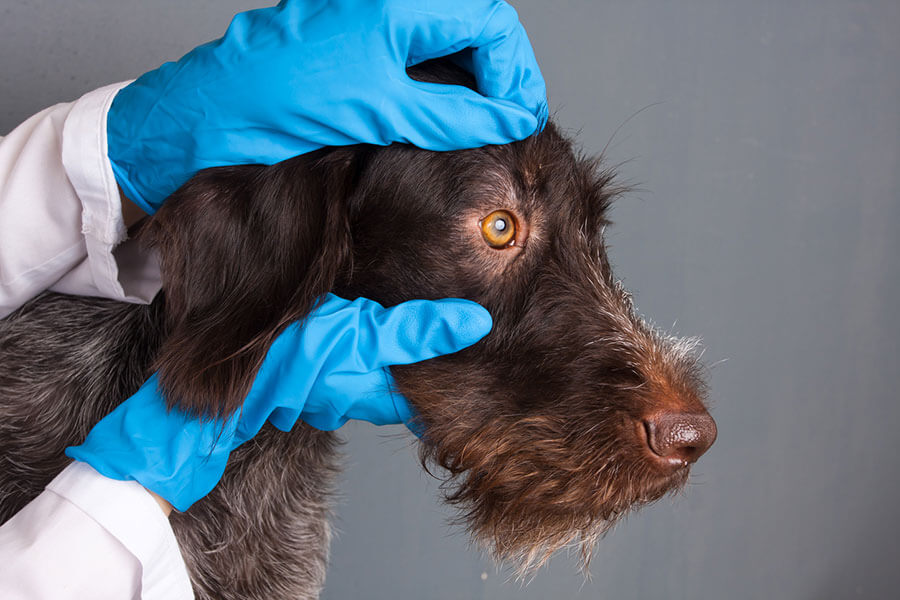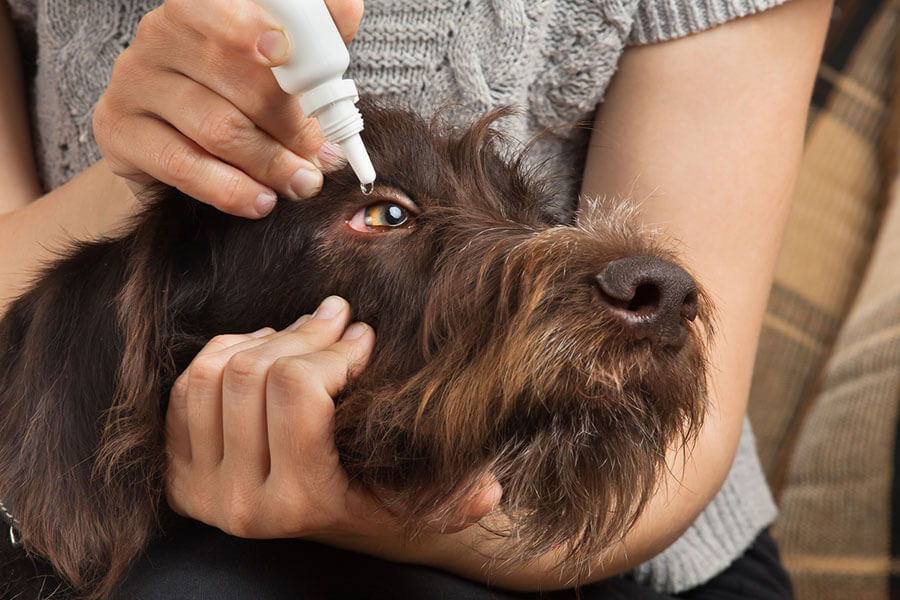How To Take Care of a Dog Eye Infection
•Posted on February 16 2023
Last updated on December 01 2025

A number of factors can cause an eye infection in dogs, including allergies, glaucoma, bacterial contamination, viruses and foreign objects. Your pet has absolutely no compunction about rolling in dirt or diving in dirty water, which could contribute to an eye infection.
A condition such as pink eye or conjunctivitis can seriously damage the inner structures of your dog's eye if not treated on time. Symptoms of a dog eye infection often include inflammation, discharge, and redness. We have found some great health tips to help you understand how to clean a dog’s eye infection and take care of your pet.
If your pet has eye discharge, it might indicate an eye injury or infection. It’s a good idea to take your dog to the vet to get to the root of the problem and prevent the loss of an eye or blindness. To know what you are dealing with, you’ll first need to get familiar with common dog eye infection symptoms and conditions.
Common eye diseases in dogs:
Dog conjunctivitis
Conjunctivitis in dogs is often followed by a watery eye discharge or mucus and yellow-green pus. A lot of things can cause conjunctivitis, like tear duct problems, allergies, dry eye, infection and foreign objects.
Before you can treat conjunctivitis, you need to learn what's causing this condition. Depending on the cause, dog conjunctivitis treatment can include pain medications, saline washes, antibiotics or simply removing an irritant.
Entropion in Dogs
Also known as excessive tearing, entropion results in smelly, stained fur or infected skin. Conditions such as corneal ulcers, allergies, inflammation or abnormal eyelashes are the main causes. Treatment for excessive tearing depends on its cause and vets usually prescribe topical medications and antibiotics.

Dry eye
A tenacious and sticky eye discharge could result from a dry eye. Your canine's eyes aren't able to produce enough eye-cleansing tears. Common dog eye infection symptoms include inflammation and mucus, which could be caused by an injury, distemper, or an autoimmune disease.
Dogs with “dry eye” are at serious risk of infection, which can lead to painful, inflamed eyes. Artificial tears are used to treat mild dry eyes, and if your dog is struggling with a secondary infection, you may need to apply antibiotic drops. In some cases, surgery is necessary.
Glaucoma in dogs
The first signs of a dog eye infection include tearing, bulging, and cloudy eyes. Glaucoma tends to cause a lot of pain, while veterinarians will try to manage the ocular pressure with drugs.
Cataracts in Dogs
Cataracts are a common cause of worsening eyesight in canines, especially as they get older. You may notice signs like dogs cloudy eyes. While this condition is painless, it can lead to blindness.
Symptoms of a Dog Eye Infection
- Redness: Your pet's eyes may be redder or pinker than usual.
- Discharge: If you notice eye discharge or eye boogers from one or both eyes, it means your dog is fighting some sort of infection. Pay attention to the colour and thickness. Your dog will require immediate veterinary care if the discharge is white, green or yellow and thicker than normal.
- Pawing at eyes: Eye infections are painful and itchy, so pawing at the eyes is typical dog behaviour. Your pet may drag their face across your furniture and floors. These actions can further damage your dog's eyes, like scratching the surface of their cornea. Your dog might need to wear an Elizabethan collar while the infection is being treated.
- Squinting: Pain and irritation can lead to excessive blinking or squinting or the affected eye.
- Swelling: An eye infection can cause the tissue surrounding the eye to swell, resulting in droopy-looking eyes.

Common causes of eye problems in dogs
There are many reasons why dogs develop an infection, red eye and conjunctivitis. Some of them include the following:
- Allergies: Allergens such as pollen, flower, grass and trees can cause discharge in the eyes, redness and itchiness. Allergies are the first thing vets suspect regarding the red eye in dogs.
- Irritants: Objects such as foxtails, sand, dust and other foreign items can irritate your pet's eye, causing redness and inflammation of the tissue surrounding the eye.
- Infection: Viruses, fungi, bacteria and other microorganisms can infect your dog's eyes. Parasite medications and vaccinations can help your pet minimise these risks.
- Cherry eye: This condition causes an inflammation of a gland within the third eyelid, which will stick to the eye's surface. Typically, surgery is required to control and correct the cherry eye.
- Trauma: Any kind of trauma to the face or head, like rough play, can cause a red eye.
How to Clean a Dog's Eyes
Before applying any method, it's important to follow your vet's instructions; otherwise you risk your pet's eyesight.
1. Start with a sterile environment
Eye infections in dogs can be messy, painful and uncomfortable. When cleaning their eyes, make sure that your hands and tools are clean and sterile and be careful when applying anything around the eye area. If required, gently place your finger under the lower eyelid and slightly pull to apply eye drops.
2. Rinse eye area
Use a simple saline solution to rinse your dog's eye area. You can purchase this solution from a veterinarian or make one at home. Mix one tablespoon of salt with a cup of warm water. Dip a cotton ball into a solution and carefully wipe away discharge from their eye. Make sure to do this a couple of times a day or use artificial tears.
3. Remove the hair
If hair around the eyes gets in their way, carefully trim it to prevent contamination from building around the eyes. This will allow discharge to drain.
4. Apply compress
You could apply a damp, warm cloth over your canine's eye and hold it for five minutes to soothe the infected area. If both eyes are infected, clean the cloth before you apply it to the other eye.
What does a healthy eye look like?
Healthy eyes in canines should be clear of debris, bright and clean, contrary to dogs with bloodshot eyes. There shouldn't be any discharge and their eyes need to be bright, moist and react to light. The pupils should be of equal size as well.
Can you prevent dog eye infections?
Canines love to explore their surroundings, so keeping their eyes safe from infection can be challenging, even for the most dedicated pet owners. Thankfully, your dog's eyelashes and eyelids do a pretty good job of protecting their eyes.
If your dog is restless and frequently suffers from eye injuries, you should consider getting them eye protection. Another useful tip would be to trim the hair around their eyes to prevent irritation. Seek professional help and take your pet to a dog groomer to avoid using scissors around their eyes.
What is the difference between a bacterial and viral infection?
Bacteria are cell organisms that can survive inside or outside the human body. Viruses aren't made of cells but of a set of genes and require a host to multiply. As the name implies, the first infection is caused by bacteria, while the second is caused by a virus.
It's crucial to distinguish between these two because it will affect the veterinary treatment. Bacteria are treated with antibiotic medications and antibiotics aren't effective against viruses. Giving your dog antibiotics against viral infections could worsen this problem and lead to antibiotic resistance.

How to improve your dog's eyesight?
One of the easiest ways to improve your pet's eyesight is to feed them food rich in antioxidants. Many eye supplements for dogs contain antioxidants. If you want to boost your dog's eyesight and prevent different types of infections, here are a few options to explore.
- Special food: Some types of foods, such as turmeric, eggs, frozen salmon, sweet potatoes, broccoli, kale, carrots and blueberries can help your dog improve their eyesight.
- Medications: If your pet suffers from poor eyesight, medications prescribed by a vet could be highly beneficial. Depending on your canine's condition, your veterinarian will prescribe different medications, like antibiotics or eye drops.
- Supplements: Another way to boost your pets' eyesight is by giving them supplements specifically designed for this purpose. Eye supplements should contain ingredients like vitamin C, rosmarinic acid, alpha lipoic acid, grape seed extract, EPA, DHA, green tea leaf extract and others.
How does a veterinarian diagnose a dog eye infection?
Diagnosing a dog's eye infection and identifying symptoms typically involves a physical examination of the affected eye and a review of the dog's medical history. During the examination, the vet will look for signs of redness, swelling, discharge and any changes in the shape or appearance of the eye.
They may perform tests such as a fluorescein stain test, which involves putting a special dye on the eye to detect any scratches or abrasions, or a Schirmer tear test to assess the amount of tear production. In some cases, the veterinarian may need to collect a sample of the discharge from the eye for laboratory analysis to identify the type of infection and determine the best course of treatment for your dog.
In addition to the physical examination, the vet may take x-rays or perform an ultrasound to rule out any underlying conditions contributing to the eye infection. Once a diagnosis has been made, the vet will discuss the best treatment options, including how to treat a dog eye infection with eye drops, antibiotics, or other medications, and suggest appropriate veterinary care for your puppy. In severe cases, surgery may be necessary.
What are the benefits of eye dog supplements?
Eye supplements are great due to their health-boosting properties. In addition to supporting the canine's eyesight, supplements are packed with powerful ingredients, contributing to the dog's overall well-being.
- Improves eye vision and health: Dog eye supplements contain omega-3 fatty acids and antioxidants that can improve your pet's vision and support different eye structures.
- Increases retinal response: Lutein is an antioxidant widely used in these supplements and will improve retinal response, which causes dogs to have poor eyesight in the first place.
- Eliminates free radicals: Antioxidants like Vitamin C and E neutralise free radicals and boost eye health. Antioxidants support the immune system as well.
Do eye supplements for dogs work?
Yes, they absolutely work! Pet parents need to be consistent and give their dogs a daily dose of eye supplements. Continuous use will improve eye health and vision, especially in older dogs. You can use eye supplements as a preventive treatment so your pet doesn't suffer from poor eyesight as they reach their senior years.
While dog eye infections may not always be life-threatening, you should check them right away to prevent further damage to your dog’s eyesight. Make sure to apply some of the tips mentioned in this article because you will know what to do for a dog eye infection when a problem arises.


